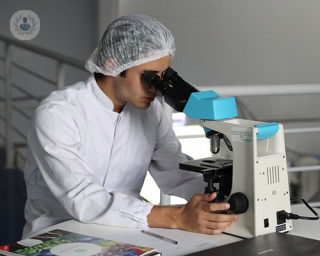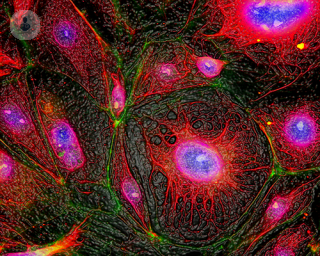What is prostate cancer?
Prostate cancer is the type of cancer that starts in the prostate gland. The prostate is part of the male reproductive system and is an organ that surrounds the urethra, the tube that carries urine out of the body. The prostate is responsible for producing seminal fluid.
Prostate cancer is the most common cancer in men, with 1 in 8 men affected. Every year, 11,000 men die from prostate cancer.
Prostate cancer can be categorised into four stages, indicating how far the cancer has spread:
- Stage 1 – the cancer is in only half of one side of the prostate and is contained within the prostate gland
- Stage 2 – the cancer is still in one side of the prostate but fills more than half of that side
- Stage 3 – the cancer has broken through the prostate gland and may spread to the seminal vesicles
- Stage 4 – the cancer has spread to the bladder, lymph nodes, bones, or other organs in the body

What are the symptoms?
Prostate cancer often does not present any symptoms at first. The symptoms that occur when the cancer starts to progress include:
- difficulty and pain when urinating
- needing to urinate frequently
- painful ejaculation
- blood in the urine
If the cancer spreads to the lymph node or pelvic bone, symptoms can include:
- pain in the lower back and pelvis that does not go away over time
- involuntary weight loss
Causes of prostate cancer or why it occurs
The exact cause of prostate cancer is unknown. Your risk of getting prostate cancer depends on:
- your age – prostate cancer is more common in men over 60 years old, and by the age of 80, 4 out of 5 men have cancer cells in their prostate
- your ethnicity – prostate cancer is more common in black men compared to white and asian men
- family history – you are twice as likely to develop prostate cancer if you have a father who had the disease
How is prostate cancer diagnosed?
Prostate cancer diagnosis consists of several stages. At first, the doctor will assess your likelihood of having prostate cancer by taking a urine sample, testing your blood for prostate-specific antigen (PSA), and examining your prostate. If they conclude you may have a high risk of prostate cancer, they will refer you for further tests. This can include:
- an MRI scan to create a detailed picture of your prostate and any cancer cells
- a biopsy to retrieve a small amount of tissue for testing
What is the treatment?
Treatment options depend on the stage of the cancer and the state of health of the patient.
For slow-growing cancer that is contained within the prostate cancer, the doctor may suggest a wait and see approach, where the prostate is regularly monitored but treatment delayed until necessary.
If the cancer requires treatment but has not spread outside the prostate gland, the most common treatments are:
- partial ablation – this treats part of the prostate that has cancer, preserving the rest of the prostate
- surgery – this can include radiotherapy or prostatectomy
If the cancer has spread beyond the prostate, the first line of treatment is hormone therapy. If this is not effective, chemotherapy or immunotherapy may be recommended. Prostate cancer is treated by a urologist or medical or clinical oncologist.
11-13-2012 10-10-2023Prostate cancer
What is prostate cancer?
Prostate cancer is the type of cancer that starts in the prostate gland. The prostate is part of the male reproductive system and is an organ that surrounds the urethra, the tube that carries urine out of the body. The prostate is responsible for producing seminal fluid.
Prostate cancer is the most common cancer in men, with 1 in 8 men affected. Every year, 11,000 men die from prostate cancer.
Prostate cancer can be categorised into four stages, indicating how far the cancer has spread:
- Stage 1 – the cancer is in only half of one side of the prostate and is contained within the prostate gland
- Stage 2 – the cancer is still in one side of the prostate but fills more than half of that side
- Stage 3 – the cancer has broken through the prostate gland and may spread to the seminal vesicles
- Stage 4 – the cancer has spread to the bladder, lymph nodes, bones, or other organs in the body

What are the symptoms?
Prostate cancer often does not present any symptoms at first. The symptoms that occur when the cancer starts to progress include:
- difficulty and pain when urinating
- needing to urinate frequently
- painful ejaculation
- blood in the urine
If the cancer spreads to the lymph node or pelvic bone, symptoms can include:
- pain in the lower back and pelvis that does not go away over time
- involuntary weight loss
Causes of prostate cancer or why it occurs
The exact cause of prostate cancer is unknown. Your risk of getting prostate cancer depends on:
- your age – prostate cancer is more common in men over 60 years old, and by the age of 80, 4 out of 5 men have cancer cells in their prostate
- your ethnicity – prostate cancer is more common in black men compared to white and asian men
- family history – you are twice as likely to develop prostate cancer if you have a father who had the disease
How is prostate cancer diagnosed?
Prostate cancer diagnosis consists of several stages. At first, the doctor will assess your likelihood of having prostate cancer by taking a urine sample, testing your blood for prostate-specific antigen (PSA), and examining your prostate. If they conclude you may have a high risk of prostate cancer, they will refer you for further tests. This can include:
- an MRI scan to create a detailed picture of your prostate and any cancer cells
- a biopsy to retrieve a small amount of tissue for testing
What is the treatment?
Treatment options depend on the stage of the cancer and the state of health of the patient.
For slow-growing cancer that is contained within the prostate cancer, the doctor may suggest a wait and see approach, where the prostate is regularly monitored but treatment delayed until necessary.
If the cancer requires treatment but has not spread outside the prostate gland, the most common treatments are:
- partial ablation – this treats part of the prostate that has cancer, preserving the rest of the prostate
- surgery – this can include radiotherapy or prostatectomy
If the cancer has spread beyond the prostate, the first line of treatment is hormone therapy. If this is not effective, chemotherapy or immunotherapy may be recommended. Prostate cancer is treated by a urologist or medical or clinical oncologist.


What is a PSE test, and how accurate is it?
By Mr Mathias Winkler
2025-01-15
The PSE test refers to a Prostate-Specific Episwitch test, a new precision medicine tool used to evaluate the presence of prostate cancer. This test was developed in the UK by Oxford university scientists and clinically validated by clinician scientists from Imperial College (Matt Winkler) and East Anglia University (Dmitry Pshezhetskiy). It measures a person's epigenetic signature, which is how our genes are expressed throughout our lives under the influence of the environment, lifestyle and diet. Find out more in this informative article. See more


Male castration, longevity and testosterone: What does the data tell us?
By Mr Mahantesh Karoshi
2025-01-15
Leading women’s health expert and consultant gynaecologist Mr Mahantesh Karoshi sheds light on the association between male castration and longevity, and discusses the associated implications of this phenomenon on the effects of hormone replacement therapy in women. See more


Diagnosing prostate cancer - having a transperineal prostate biopsy
By Professor Francis Chinegwundoh MBE
2025-01-15
1 in 8 men in the UK will receive a diagnosis of prostate cancer in their lifetime. The prostate is a male gland located between the bladder and penis, surrounding the urethra. The prostate grows in size with age and its main purpose is to help make semen, which is the fluid that carries the sperm. Professor Francis Chinegwundoh MBE, a renowned urologist, explains how prostate cancer can be diagnosed with a transperineal prostate biopsy. See more


What does a pathologist examine?
By Dr Ashish Chandra
2025-01-15
We ask our expert pathologist Dr Ashish Chandra what he examines in tissues and cells, which tools he uses to do it and just what exactly he is looking for. See more
Experts in Prostate cancer
-
Mr Christopher Anderson
UrologyExpert in:
- Kidney cancer
- Laparoscopy
- Prostate cancer
- Robotic surgery in urology
- Prostatectomy (prostate removal)
- Prostate biopsy
-
Mr Sarb Sandhu
UrologyExpert in:
- Prostate
- Vasovasostomy (vasectomy reversal)
- Vasectomy
- Prostate cancer
- Bladder problems
- Bladder cancer
-
Professor Hashim Uddin Ahmed
UrologyExpert in:
- Cryosurgery
- Prostate
- Rezūm
- Green light laser surgery
- Prostate cancer
- Prostate biopsy
-
Mr Keng Jin Ng
UrologyExpert in:
- Laser lithotripsy
- Urinary incontinence in women
- Female urology
- Cystitis
- Prostatitis
- Prostate cancer
-
Mr Marc Laniado
UrologyExpert in:
- HIFU (high-intensity focused ultrasound)
- Holmium laser (HoLEP)
- Prostate cancer
- Prostatectomy (prostate removal)
- NanoKnife
- See all

Syon Clinic - part of Circle Health Group
Syon Clinic - part of Circle Health Group
941 Great West Rd, Brentford TW8 9DU
No existe teléfono en el centro.
By using the telephone number provided by TOP DOCTORS, you automatically agree to let us use your phone number for statistical and commercial purposes. For further information, read our Privacy Policy
Top Doctors

Cleveland Clinic Moorgate Outpatient Centre
Cleveland Clinic Moorgate Outpatient Centre
55 Moorgate, EC2R 6BH
No existe teléfono en el centro.
By using the telephone number provided by TOP DOCTORS, you automatically agree to let us use your phone number for statistical and commercial purposes. For further information, read our Privacy Policy
Top Doctors

West Valley Hospital
West Valley Hospital
Level 9, Interchange 81 - 85 Station Road, Croydon, CR0 2RD
No existe teléfono en el centro.
By using the telephone number provided by TOP DOCTORS, you automatically agree to let us use your phone number for statistical and commercial purposes. For further information, read our Privacy Policy
Top Doctors
-
Syon Clinic - part of Circle Health Group
941 Great West Rd, Brentford TW8 9DU, West LondonExpert in:
- Allergies nose and ears
- Allergy Dermatitis
- Allergy
- Clinical analysis
- Anxiety
- Digestive
-
Cleveland Clinic Moorgate Outpatient Centre
55 Moorgate, EC2R 6BH, Central LondonExpert in:
- Digestive
- Cardiology
- Dermatology
- Diagnostic Imaging
- Diagnostics
- Obstetrics and Gynaecology
-
West Valley Hospital
Level 9, Interchange 81 - 85 Station Road, Croydon, CR0 2RD, South LondonExpert in:
- General Surgery
- Orthopaedic surgery
- Plastic surgery, reconstructive and aesthetics
- Gastroenterology
- Ophthalmology
- Urology
- See all
- Most viewed diseases, medical tests, and treatments
- Immunotherapy
- Fertility preservation
- Female infertility
- CAR-T cells
- Hormone therapy
- Undescended testicle (Cryptorchidism)
- Hodgkin's lymphoma
- Genetic testing
- Testicular ultrasound
- Nipple discharge







